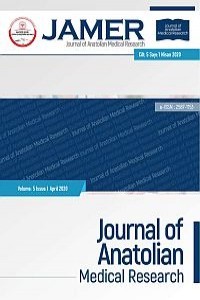Adolesan idiopatik Skolyozda Semptomlar ve Klinik Takip
Özet
Giriş: Adolesan idiopatik skolyozlu (AİS) genelde tesadüfen veya okul taramalarında ortaya çıkar. AİS’da tanı, tedavi ve takip için ayrıntılı öykü, muayene ve radyolojik incelemeler yapılmalıdır.
Bulgular: AİS’da ağrı sık gözlenen bir durum değildir. Skolyozlu bir hastada ağrı kifoz veya altta yatan potansiyel bir lezyonun habercisidir. Psikiatrik problemler büyük eğriliklerde gözlenebilir. Erken ölüme yol açmayan nefes darlığı gibi pulmoner semptomlar genelede 60-80 derece üzeri eğriliklerde görülür. Eğri ilerlemesini etkileyen tanı yaşı, menarş durumu, trianguler fibrokartilajın kapanıp kapanmadığı, Risser evresi, Sanders evresi klinik takipte önemlidir.
Sonuç: AİS sıklıkla asemptomatik seyreder. Klinik takipte tanı yaşının küçük olması, kız cinsiyet, premenarş ve menarş sonrası 1 yıl, Risser-Sanders evresinin küçük olması, başlangıçta yüksek açı, torakal eğrilikler progresyon riskinin habercisidir.
Symptoms and Clinical Follow-up in Scoliosis
Abstract
Introduction: The curvature is usually discovered incidentally or during school screening, except that the individual with adolescent idiopathic scoliosis (AIS) is noticing the curvature. Detailed history, examination and radiological examinations should be performed for diagnosis, treatment and follow-up in AIS.
Results: Pain is not a common condition in AIS. In a patient with scoliosis, pain is a precursor of kyphosis or a potential underlying lesion. Psychiatric problems can be observed in large curves. Pulmonary symptoms such as shortness of breath are generally seen in curves above 60-80 degrees. The age at diagnosis, menarche status, open of triangular fibrocartilage, Risser stage, Sanders stage, which affect the curve progression, are important in clinical follow-up.
Conclusion: AIS is often asymptomatic. Small age at diagnosis, female gender, premenarche and 1 year after menarche, low Risser-Sanders stage, high angle at the beginning, and thoracic curvatures in clinical follow-up are predictors of the risk of progression.
Anahtar Kelimeler:
Adolesan idiopatik skolyoz, Risser evresi, Sanders evresi
Symptoms and Clinical Follow-up in Adolescant Idıopathic Scoliosis
___
- 1. Grivas TB. The Conservative Scoliosis Treatment:1st SOSORT Instructional Course Lectures Book: IOS Press; 2008.
- 2. Altaf F, Gibson A, Dannawi Z, Noordeen H. Adolescent idiopathic scoliosis. Bmj. 2013;346.
- 3. Feldman DS, Straight JJ, Badra MI, Mohaideen A, Madan SS. Evaluation of an algorithmic approach to pediatric back pain. Journal of Pediatric Orthopaedics. 2006;26(3):353-7.
- 4. https://www.mayoclinic.org/diseases-conditions/scoliosis/symptoms-causes/syc-20350716). [
- 5. Ramirez N, CHARLES E JOHNSTON I, Browne RH. The prevalence of back pain in children who have idiopathic scoliosis. JBJS. 1997;79(3):364-8.
- 6. Weinstein S, Zavala D, Ponseti I. Idiopathic scoliosis: long-term follow-up and prognosis in untreated. J Bone Joint Surg Am. 1981;63:702-12.
- 7. Ascani E, Bartolozzi P, Logroscino C, Marchetti P, Ponte A, Savini R, et al. Natural history of untreated idiopathic scoliosis after skeletal maturity. Spine. 1986;11(8):784-9.
- 8. Negrini S, Aulisa AG, Aulisa L, Circo AB, De Mauroy JC, Durmala J, et al. 2011 SOSORT guidelines: orthopaedic and rehabilitation treatment of idiopathic scoliosis during growth. Scoliosis. 2012;7(1):1-35.
- 9. Negrini S, Grivas TB, Kotwicki T, Maruyama T, Rigo M, Weiss HR. Why do we treat adolescent idiopathic scoliosis? What we want to obtain and to avoid for our patients. SOSORT 2005 Consensus paper. Scoliosis. 2006;1(1):1-14.
- 10. Rolton D, Nnadi C, Fairbank J. Scoliosis: a review. Paediatrics and child health. 2014;24(5):197-203.
- 11. Weinstein S, Ponseti I. Curve progression in idiopathic scoliosis. The Journal of bone and joint surgery American volume. 1983;65(4):447-55.
- 12. Sanders JO. Maturity indicators in spinal deformity. JBJS. 2007;89(suppl_1):14-20.
- 13. Weinstein SL, Dolan LA, Cheng JC, Danielsson A, Morcuende JA. Adolescent idiopathic scoliosis. The lancet. 2008;371(9623):1527-37.
- 14. Rogala EJ, Drummond DS, Gurr J. Scoliosis: incidence and natural history. A prospective epidemiological study. The Journal of bone and joint surgery American volume. 1978;60(2):173-6.
- 15. Lonstein JE, Carlson J. The prediction of curve progression in untreated idiopathic scoliosis during growth. The Journal of bone and joint surgery American volume. 1984;66(7):1061-71.
- 16. Buckler JM. Growth of the limbs and trunk. A longitudinal study of adolescent growth: Springer; 1990. p. 36-58.
- 17. Grivas TB, Vasiliadis E, Mouzakis V, Mihas C, Koufopoulos G. Association between adolescent idiopathic scoliosis prevalence and age at menarche in different geographic latitudes. Scoliosis. 2006;1(1):1-12.
- 18. Nachemson AL, Sahlstrand T. Etiologic factors in adolescent idiopathic scoliosis. Spine. 1977;2(3):176-84.
- 19. Greulich WW, Pyle SI. Radiographic atlas of skeletal development of the hand and wrist: Stanford university press; 1959.
- 20. Nachemson AL, Peterson L-E, Bradford D, Burwell R, Duhaime M, Edgar M, et al. Effectiveness of treatment with a brace in girls who have adolescent idiopathic scoliosis. A prospective, controlled study based on data from the Brace Study of the Scoliosis Research Society. Journal of Bone and Joint Surgery-Series A. 1995;77(6):815-22.
- 21. Picault C, Demauroy J, Mouilleseaux B, Diana G. Natural history of idiopathic scoliosis in girls and boys. Spine. 1986;11(8):777-8.
- 22. Horne JP, Flannery R, Usman S. Adolescent idiopathic scoliosis: diagnosis and management. American family physician. 2014;89(3):193-8.
- 23. Charles YP, Daures J-P, de Rosa V, Diméglio A. Progression risk of idiopathic juvenile scoliosis during pubertal growth. Spine. 2006;31(17):1933-42.
- 24. Yaman O, Dalbayrak S. Idiopathic scoliosis. Turkish neurosurgery. 2014;24(5).
- 25. Villemure I, Aubin C, Dansereau J, Labelle H. Biomechanical simulations of the spine deformation process in adolescent idiopathic scoliosis from different pathogenesis hypotheses. European spine journal. 2004;13(1):83-90.
- 26. Wong H-K, Tan K-J. The natural history of adolescent idiopathic scoliosis. Indian journal of orthopaedics. 2010;44(1):9-13.
- 27. American Collage of Rheumatology. ACR-SPR-SSR practice parameter for the performance of radiography for scoliosis in children. 2014. Available at: http://www.acr.org/Quality-Safety/Standarts-Guide-lines/Practice-Guidelines-by-Modality/Pediatric. [
- 28. Hoffman DA, Lonstein JE, Morin MM, Visscher W, Harris III BS, Boice Jr JD. Breast cancer in women with scoliosis exposed to multiple diagnostic x rays. JNCI: Journal of the National Cancer Institute. 1989;81(17):1307-12.
- 29. Beals RK, Robbins JR, Rolfe B. Anomalies associated with vertebral malformations. Spine. 1993;18(10):1329-32.
- 30. Ferguson RL. Medical and congenital comorbidities associated with spinal deformities in the immature spine. JBJS. 2007;89(suppl_1):34-41.
- Yayın Aralığı: Yılda 3 Sayı
- Başlangıç: 2016
- Yayıncı: Kayseri EAH
